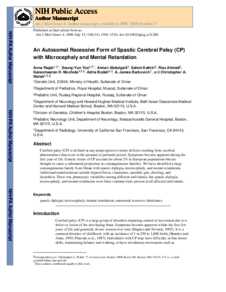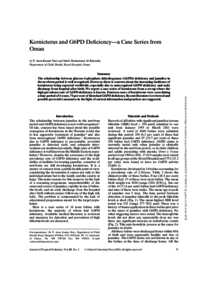Document
An autosomal recessive form of spastic cerebral palsy (CP) with microcephaly and mental retardation.
Identifier
DOI: 10.1002/ajmg.a.31288
Source
American Journal of Medical Genetics, Part A. v. 140, 14, p. 1504-1510
Contributors
Yoo, Seung-Yun., Author
Abdulgalil, Aiman., Author
Kathiri, Salem., Author
Ahmed, Riaz., Author
Mochida, Ganeshwaran H., Author
Bodell, Adria., Author
Barkovich, A. James., Author
Walsh, Christopher A., Author
Country
United States.
City
Hoboken
Publisher
Wiley
Gregorian
2006-07-15
Language
English
English abstract
Cerebral palsy (CP) is defined as any nonprogressive motor deficits resulting from cerebral abnormalities that occur in the prenatal or perinatal period. Symptoms become apparent during the first year of life. Genetic forms of CP account for about 2% in European populations but are thought to cause a substantial proportion in consanguineous families. We have identified a large consanguineous family from Oman with spastic diplegia, microcephaly, and mental retardation. Additional manifestations include hyperreflexia, clumsiness, unstable gait, drooling, and dysarthria. There was phenotypic variability among different individuals, but spastic diplegia, microcephaly, and mental retardation were three constant traits present in all affected individuals.
ISSN
1552-4825
Resource URL
Category
Journal articles


